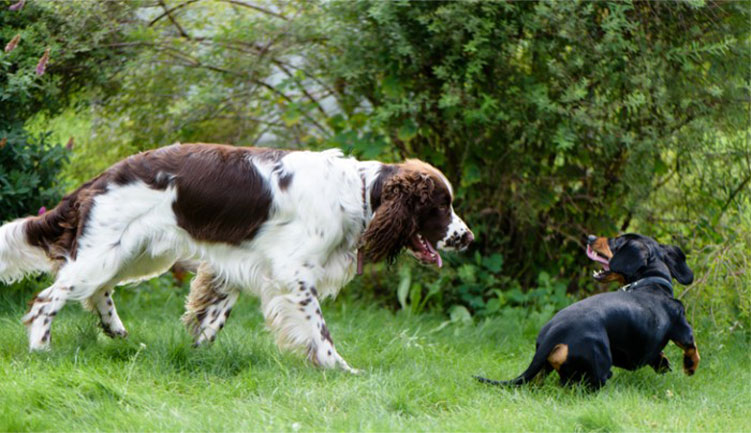How to Train Your Dog More Effectively: Indulge Their Inner Wolf
The deep relationship between humans and dogs was forged centuries ago when humans first befriended wolves. Inside every domesticated dog still beats the heart of a wolf. Are you wondering how to train your dog more effectively? Indulge their wild soul.
DOG TIPS AND TRICKS DOGS

Posted by bravectosouthafrica – 14 September 2020
Humans and Dogs: In a Long-Term Best Friend Relationship for 30,000+ Years
You can trace the relationship between humans and dogs way, way back. More than 30,000 years, in fact. It all began when nomads first domesticated and started training wolves to use as protectors when they hunted. To do this, humans started feeding the wolves for their trouble. This arrangement suited the wolves just fine.
Our domesticated dogs of today are the product of thousands of years of breeding. Throughout all of the centuries the bond between man and canine has only grown deeper and stronger. We essentially became each other’s best friends forever.
Within every modern house-trained dog, a tiny bit of the essence of their ancient wolf ancestors remain. When training dogs, it is a good idea to keep this in mind. Try to think as much like a wolf as possible when you are busy socialising and training your pack of dogs.
To do dog training right doesn’t have to be hard for both parties. Read on to discover how to train dogs by adopting a wolf mindset.

The Hierarchy in a Wolf Pack
Wolves in the wild live in familial groups called packs. The members of the pack can be seen as close to each other. When hunting, they do it together as a group and will collectively work to keep their pups safe from harm. There is a set hierarchy within these packs, where the wolf parents can be found at the very top. This pecking order is used to control access to different resources like food. Wolves at the top of the order have the opportunity to eat first.
One of the first things ancient wolves had to do was learn that fighting inside their own pack doesn’t do any members any good. They figured this out pretty quickly as a hostile situation could escalate and ultimately lead to serious injuries that end up harming the success of hunting efforts, as well as the survival of the pack as a whole.
The pack’s highest-ranking members can often be seen behaving in a diplomatic fashion. They try to settle any disputes within their pack without having to resort to violence. To do this a high-ranking wolf will typically show off their superiority by completely ignoring any defiant members in the pack and will back down when tempers flare.

The Hierarchy in the Human-Dog Relationship
As soon as a new dog joins your family, they become a member of your pack. This is the way that your dog sees it and it’s ingrained in their canine being. Dogs are bright creatures. They recognise that you are not the same species but they still expect all of their human family members to be ranked too.
Without having to train them, your new dog will accept that adult members of the family rank higher on the pack hierarchy than they do. This is due to various contributing factors such as the fact that humans tower over dogs. Since we stand upright, we are physically bigger than our canine companions and thus more imposing. Another important thing to keep in mind is that the new dog is moving into your territory and not the other way around. Once your new dog is in your established territory, you are the one that controls their access to various resources, including food and water, as well as general care.
Dogs have absolutely no reason to doubt that you and their other human pack members outrank them in the household hierarchy. Dog training doesn’t have to teach them that.
Let’s move on to how to train a dog when they join your family.

How to Go About Domesticating and Training Your New Dog Family Member
As soon as you introduce a new dog into your family, you need to get them use to living in your (often complicated) world and get them to start following your household rules. The most effective way of training your dog is through consistent trial and error training efforts. Offering up rewards during dog training will help your dog come to associate certain behaviours as desirable, while negative experiences will have the opposite effect on your dog. Bad experiences during dog training will tell your dog that the behaviour they displayed should be avoided.
Please do, however, keep in mind that your dog should never and under no circumstances be physically punished during training or on any other occasion. There are far more humane ways to show your dog that you are displeased with their behaviour when training them.
All that physical punishments and/or threats during dog training will get you is a loss of trust between you and your dog. You may be surprised to learn how dog training with violence and aggression can lead to your dog displaying the exact opposite of the intended behaviour you are reprimanding them for. For example: if you punish your dog for growling with violence, you may cause them to resort to biting you next time, to protect themselves from the punishment you dished out when you did training the last time.
Rather rethink your strategy for discouraging your dog from bad behaviours during dog training. The last thing you want to do is end up pushing your dog towards additional unwanted behaviours in times of friction. Think and act the same as a top-ranking wolf by responding with diplomacy and calmness during your training sessions.
Think the Same as a Wolf
With your new dog, be sure to reward them with a treat when they comply with your training commands and the desired behaviour. Say you want to train your new dog to come when they are called. If they do come to you, give them a yummy treat to show them how impressed you are. They will start to come to you every time they are called because they now associate this action with a positive reaction.
However, should your dog end up ignoring your call/command during dog training, then you can act like the top wolf and ignore your low-ranking dog. In most dogs’ eyes, this is already more than enough of a punishment. Proceed to work on improving this skill in training situations where you are positive that your dog will come when they are called for.
What we are saying is this: be a good owner and set your dog up for training success in the future. For the most part, you can be sure that nearly all dogs want to succeed during dog training to impress their owners. When you are happy, they are happy. Training can be a fantastic bonding exercise if done right.
Another level-headed wolf-inspired dog training method is teaching your dog alternative behaviours. Let’s say, for example, that your dog has taken to begging at the table whenever your family enjoys mealtime. Proceed to ignore this behaviour – no matter how hard it may be – until they have decided to give up and go lie down on the floor nearby. Now it’s this behaviour – going to lie down quietly – that you want to reward with a delicious treat straight away. Once again, if you practice consistency in your dog training, your dog will soon know to go and lie down on the floor as soon as your family sits down and gets ready for dinner.
The three key elements to effective dog training and socialisation are:
- persistence,
- patience,
- and consistency.
When you add a little savvy into the dog training mix you will soon prove to your new dog that you deserve to be the leader of your pack.

Think the Same as a Wolf
Your dog may have the bold and confident soul of a wolf, but that won’t stop awful external parasites from coming to infest them and your household. Bravecto® holds just the answer. For the long-lasting, fast-acting treatment of ticks, fleas and mites, choose one of our tried and tested Bravecto® for Dogs options.
Bravecto® Chew takes the form of a delicious treat and will give your dog up to 12 weeks of protection against fleas and ticks with a single dose. To administer this treatment option, simply give the chewy treat to your dog by mouth and with food.
For an alternative treatment option, opt for Bravecto® Spot-On for Dogs. This topical treatment will keep your dog safe from ticks for up to 4 months and from fleas for up to 6 months – all this in one application!
If you choose Bravecto®, your loyal pal will remain external parasite-free for 3x longer than other monthly treatments, which means you also save in the long run. Now you only have to treat your dog around four times per year and don’t have to fret about remembering to re-dose regularly. However, if you are afraid that you will forget when to re-dose, download our handy Bravecto® reminder app, create a profile for each of your pets, select the treatment used and that’s it! You will receive a notification when their next treatment is due.
You can dedicate more time and energy to training your dog and less worrying about them falling ill from a parasite-related disease. We care about you and your furry friends, so focus on the training, forget about the fleas and trust Bravecto®.
Subscribe to our Newsletter
Get to know your furry friend better! Sign up for all things dog- or cat-related.
The Hairy Facts about the dreaded hairball
12 April 2021
Help! My dog’s barking mad! Volume 2
12 April 2021
Your Itchy, Scratchy Cat – All About Cat Skin Problems
12 April 2021
The Dog’s Diet: A Bone of contention?
01 April 2021
Mango Fly Worms: How to Spot and Eliminate them
Posted on November 28,2019
Managing Mange And Mites In Your Dog
Posted on June 11,2018
Why Do Cats Purr and How? Learn What Your Cat Is Saying
Posted on October 14,2020
How to Get Rid of Ear Mites in Dogs
Posted on November 06,2019









